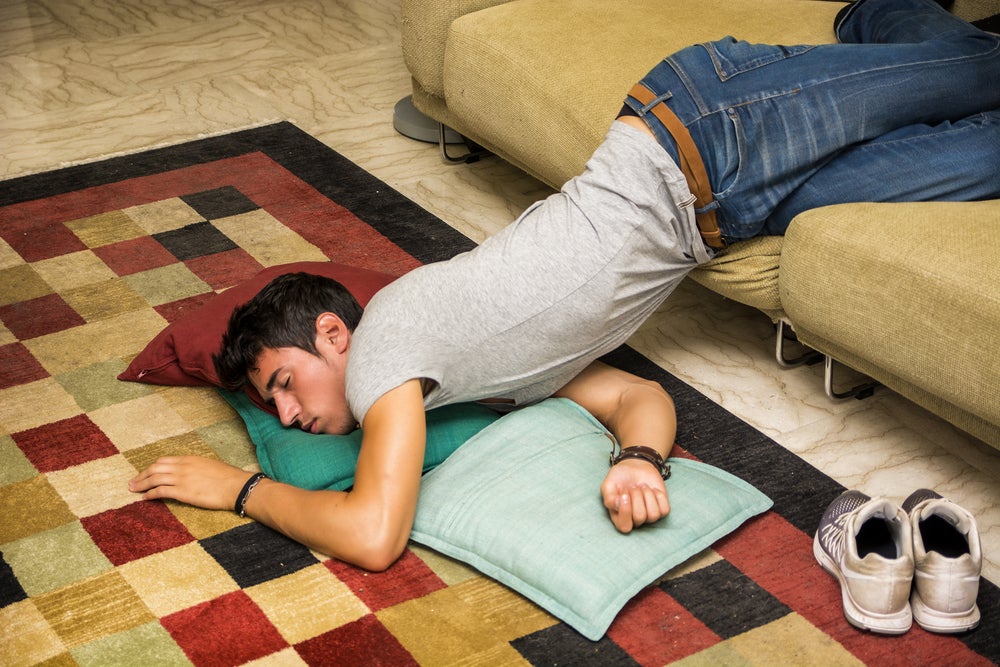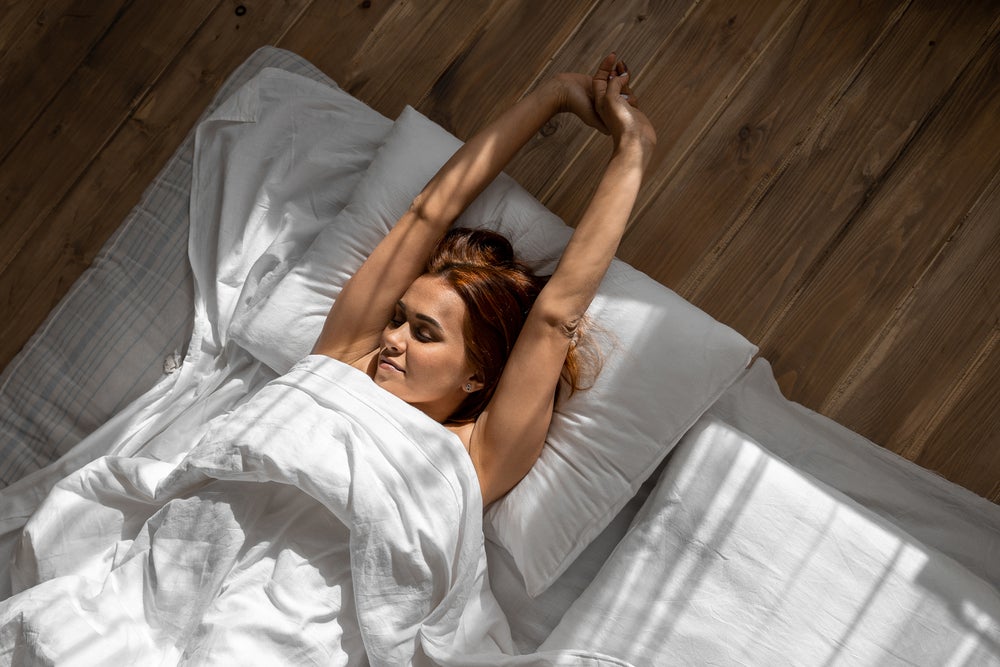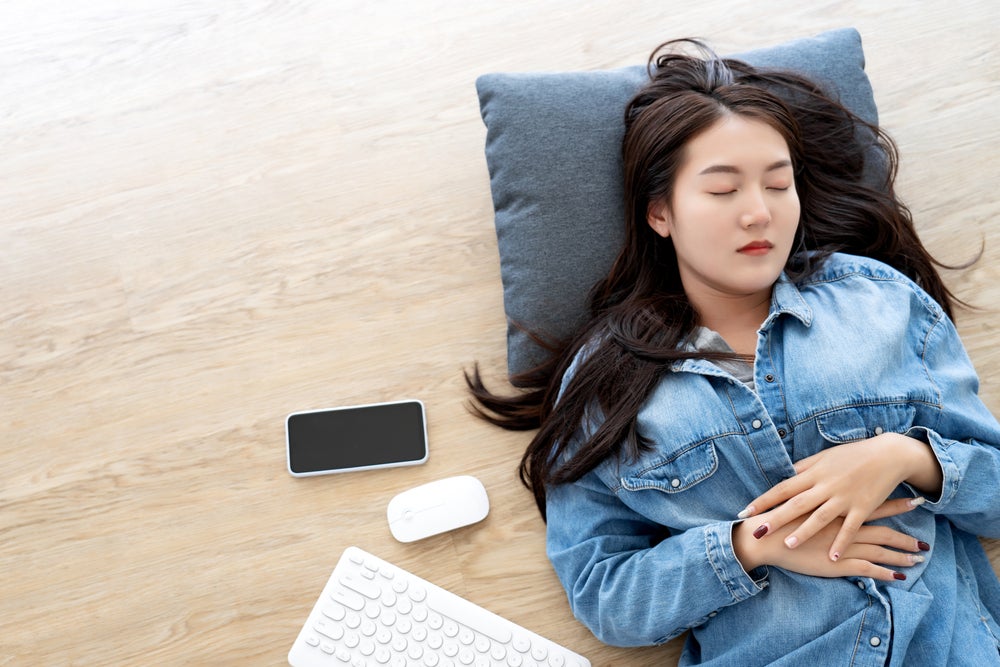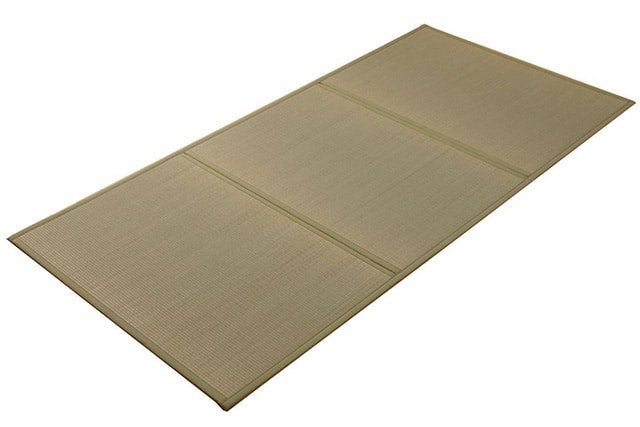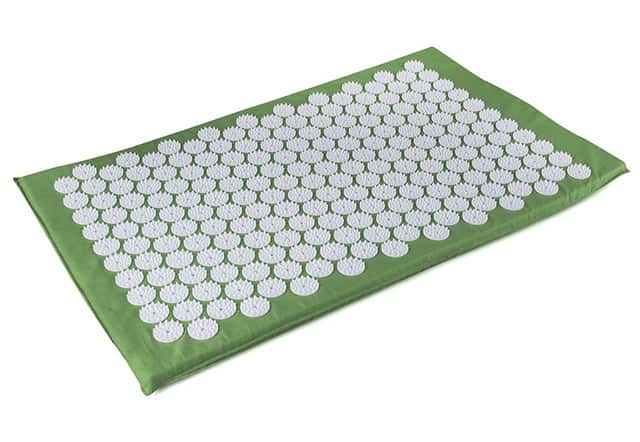It would be silly to say mattresses are pretty common. Most everyone has one, whether it be fancy or simple, new or old. Mattresses are part of our daily lives. They are what help us sleep at night comfortably. But are they the best way for us to be sleeping? Is it possible there are other options than the mattress?
For millennia, humans slept on the ground. Whether on piles of soft materials or directly on the dirt itself, the ground was our first sleeping surface. When considering that, one has to wonder: “Is this the way we were meant to sleep?”
Sleeping on the floor comes with both positive and negative aspects, but in the end, it’s all up to you to decide which outweighs the others. Let’s try to answer the burning question: Is sleeping on the floor good for you?
Your Back
Almost every benefit which comes from sleeping on the floor is going to be felt in your back. From pain to posture, the effect sleeping on the floor has on your back is pretty profound. Most every person who makes the switch will make this claim, and there’s some science behind it.
Pain
One of the first things people seem to point out when they move to sleeping on the floor is that back pain they were previously experiencing has now vanished. This is a big claim, especially when leveled against similar claims made by mattress companies for generations.
Sleeping on the floor helps your alignment in many ways. A mattress can conform to your body in similar effect, but you still sometimes end up sinking in and your body can end up a little out of whack. By sleeping on the floor, the hard surface forces your body to keep in line. You may lose the comfortable sinking sensation, but the fact your body will be better lined up means you have a better opportunity to avoid some pain.
Posture
Thanks to that added alignment assistance, sleeping on the floor also seems to help out with posture. This can be attributed to two things, the straightening of your back through proper support and because of the decrease in pain. People often slouch because standing up straight causes them pain, thanks to sleeping on a poor mattress or having developed bad habits.
Your Rest and Energy
Sleeping on the floor can also lead to feeling more rested. People who sleep on the floor find themselves not only feeling more rested, but more ready to get up in the morning. Sometimes sleeping in a bed can be too comfortable, which is why we hit the snooze button once or twice each morning.
When sleeping on the floor, you get the right quality of sleep, and you’re not so comfortable that you want to stay laying there for some time. While the initial act of sleeping on the floor can be a little uncomfortable, once you fall asleep, it doesn’t matter. Why have an amazingly comfortable mattress you only feel before you fall asleep and after you wake up?
The Downsides
In truth, there aren’t many downsides to sleeping on the floor. At least, not for healthy people. Folks who need special mattresses, such as a hospital bed, shouldn’t try to sleep on the floor. These are prescribed and designed for important purposes.
There is also a potential temperature issue. If you’ve walked around your house on bare surfaces with bare feet, you know how cold the floor can get. If you haven’t ever done this, I can assure you, the floor can get quite cold. Different flooring types warm differently, as well. So sleeping on tile or concrete might feel colder than sleeping on wood, for instance.
Finally, sex can become a somewhat awkward situation when sleeping on the floor. For a couple, it can be an uncomfortable aspect, but not impossible. For a single person bringing someone special home, it can be strange to find out someone sleeps on the floor. These issues can be combated fairly simply, however, with cushioning and discussion.
You may want to read: Is It Good for You to Sleep on a Hard Surface?
How to Sleep on the Floor
Switching to sleeping on the floor after years of sleeping on a mattress isn’t going to be easy for everyone. Some people may find it to be comfortable right away, but for those of us who have gotten used to the amazing comfort of a mattress, trading that out for a hard floor just doesn’t sound very appealing.
1. Preparing
The first part of getting ready to sleep on the floor is mental. You need to understand that, for the first few nights, you’re probably going to be a little uncomfortable. You may ache a little as your body adjusts to not sleeping on such a soft and comfy surface such as that which a mattress provides.
This adjustment period can be longer for some. Those who are overweight or already suffer from some aches may need more time than others, but eventually, it will work out.
2. The Right Surface
You may be sleeping on the floor, but that doesn’t mean you need to sleep directly on the ground. There are multiple items out there which can serve to soften the experience a little without removing the benefits. We’ll go into those in more detail later, but having the right sort of surface can make sure your experience, and your transition, are top notch.
3. To Pillow or Not To Pillow
Some people who switch to sleeping on the floor think no pillow should be used. This, they say, is more natural. There is some research which shows it may not be as necessary as one thinks. The natural way to sleep could be to use an arm to elevate your head, if needed. However, most sleep with a thin pillow, one which elevates just enough to provide support for your head and neck.
Sleeping with a whole bunch of pillows isn’t the way to go. The idea is to achieve proper alignment, and if you’re using many pillows to prop your head up because it feels nice, you are either not going to be reaping the benefits of sleeping on the floor or you’re going to find yourself with some neck aches come morning.
Sleeping Positions
Just as with sleeping on the bed, you can sleep in any number of positions while sleeping on the floor. You might think the only good option is sleeping on the back, as that would give the best support, but some research shows that may not be the case.
A physiotherapist named Michael Tetley did a study looking at many of the different sleeping methods used by people around the world and by animals in nature. In his study, he pointed out each of them and the benefits they offered. Not only did he find that people who sleep on the floor develop fewer musculoskeletal lesions, he found that sleeping in certain positions actually aided in the correction of different joints.
Sleeping on Your Side
From nature, he observed that various primates would sleep on their side. In this position, the arm can be used as a pillow. What the researcher discovered was that a pillow isn’t needed when lying on one’s side, so long as the shoulder is fully hunched, allowing for proper neck support.
In nature, he states, this would allow for the mouth to be pressed closed in order to keep insects from entering the mouth. It also maintains proper posture by helping the vertebrae align themselves as you breath. He also found that, when sleeping on your side, you can place the Achilles tendon of one foot between the big toe and the next to help correct a bunion, which is a condition involving a wonky joint in your big toe.
Sleeping on Your Stomach
When you sleep on your stomach, or as the research calls it, the quadrupedal position or the lookout posture, you can reap many healing benefits. By pushing out your elbows and sleeping on your forearms like a pillow, your spine can be correct easily. He developed this by watching the way in which four-legged animals, such as dogs, slept.
You may want to read: The Benefits Of Sleeping With Your Dog
Sleeping on Your Back
In opposition to this researcher’s results, several sources suggest sleeping on your back may be the best option to avoid pain. According to one source, sleeping on your back is the only way to ease back pain as it is the sole position which can keep the spine supported. It suggests sleeping on your side forces your hamstrings and hip flexors, as well as your pectoral muscles, to tighten over time, which can lead to additional pain.
Nature and research seem to contradict this statement, but you’ll certainly need to experiment anyway to see which positions feel best for you. Only you can decide what you want.
Choosing the Right Surface
There are myriad options out there for sleeping on the floor. Some are like firm mattresses, others simply serve as a barrier between your body and the floor. If you want to go completely natural, you don’t actually need to use a sleeping surface, though many seem to enjoy that extra little bit of comfort.
The key when choosing what you are going to sleep on is making sure you don’t use something so soft you’re going to sink into it, thereby messing up what you’re trying to accomplish. If there’s too much give, you’re not going to be getting the full benefits of sleeping on the floor, as the sleeping surface is going to be doing all the work.
Tatami
Take it from the culture which regularly sleeps on the floor to create such an ideal sleeping surface. The tatami isn’t a new invention. The Japanese have been using these mats for more than 1200 years as sleeping surfaces, among other things. They range greatly in size, from a couple inches thick to almost the size of a mattress.
Traditional Japanese housing use tatami as flooring, which makes it comfortable to walk around barefoot. Tatami are traditionally made using a rice straw core with a covering of soft rush straw, allowing it to have a little give when pressure is put upon it. More modern tatami have been known to include wood chip boards or polystyrene foam as a core.
Because of their design, they make ideal sleeping surfaces. Rather than a hard floor, these have just enough give to make you feel comfortable. In modern days, tatami has also taken on a meaning more similar to mattress, which is why you’ll sometimes see tatami as thick as a futon made exclusively for sleeping.
Futon
Speaking of futons, they can be a good alternative to a mattress for sleeping on the floor. A futon will be thick, giving it some elevation, but they aren’t typically thick enough to counter support given by hard surfaces. Whether it’s a futon which is just stuffed cloth which sits on a metal frame or a futon with a hard base and soft top layer, a futon is excellent in helping to make the transition from mattress to floor.
Yoga Mat
A yoga mat can serve a function very similar to a tatami. They are soft, countering some of the shock of sleeping on a completely firm surface, but don’t go so far as to ruin your benefits. The other benefit of the yoga mat is the price. They typically can be found for around $10, though that price can go much higher if you are looking for something a little more fancy. All in all, though, this simple thing can make a great floor sleeping mat.
Massage Mat
Yet another alternative is a massage mat. They come in many shapes and sizes, but all are thin enough to allow you to really take great advantage of sleeping on the floor. Some of their features can also counter some of the more simple downsides to sleeping on the floor. Some come with a heating ability, for instance. This is handy, as sleeping directly on the floor can sometimes be cold.
You can also go a little more traditional and get something like a Thai massage mat, which features sections of cotton or other materials to give a bit of softness in the surface. These are designed for people to lay on while getting a massage, but they can work very well as a sleeping surface.
You may be interested in: Can You Put A Mattress On The Floor? Assessing the Risks and Alternatives
More Reasons
We’ve looked at the health benefits of sleeping on the floor, but there are also some other things you may not have considered. Switching to a floor-sleeping lifestyle can lead to a better home situation on a couple different levels and can give you advantages outside the house, as well..
More Space
Picture the room in which you sleep. What takes up the most space? Unless you have a massive room with a swimming pool in it, I would bet the first thing you thought of was your bed. Or perhaps you didn’t even think about the bed because it’s a given it would be in there. Well, if you start sleeping on the floor, you won’t need that bed anymore. What does this mean? More space. A lot more space.
What can you do with this space? Anything you want. Put in some exercise equipment. Load the room up with plants. Put in some great chairs and make a special lounge room. Literally anything you can think of, you can do, because the bedroom becomes just another room, should you want that to be the case.
When using something like a tatami or yoga mat, cleanup in the morning can be even easier than making the bed. You can roll up your sleeping surface and put it away, meaning you can sleep pretty much anywhere you like in your home, since your bed has become far more portable. This leads into our next benefit.
Sleep Anywhere
Getting accustomed to sleeping on the floor means you can basically sleep anywhere you want. If you’ve got a long layover during a flight, you can easily plop down on the floor and catch some Zs whereas others would have difficulty without a mattress. Think about the naps you can have at work, or how easy you might fall asleep on camping trips or when you stay overnight with family. There is no need for extra beds when the floor is your preferred sleeping area.
Let’s Begin
Earlier we talked about what you need in order to start making the transition to sleeping on the floor, but there are also some techniques you can use to make it easier.
Going Gradually
Like any new sleep schedule, making the change a little at a time is probably the ideal way to start sleeping on the floor. The trick is to make your body so tired that falling asleep on the floor becomes easy. You increase this until you’re spending most of the night on the floor, then go the whole way. Here’s how it works.
First, set your alarm for a couple hours before you typically wake up. Instead of getting up at 8 a.m., set your alarm for 6 a.m. When your alarm goes off, get out of bed. This can be harder than it sounds because your bed is going to feel fantastic, but do it anyway.
Chances are you’re still going to be tired, so feel free to go back to sleep, but do it on the floor instead. If you’re tired enough, you’ll fall right back asleep. If you’re not, get up and enjoy a couple extra hours of early morning infomercials.
Repeat this for a few days, then make it even worse for yourself by setting your alarm ahead even further. In this example, set it for 4 a.m. instead of 6 a.m. and do the same thing. At this point, assuming you usually get eight hours of sleep, you’re going to find you’re spending half of the night on the floor, and probably already feeling better.
After a few days of this, you’ll probably be ready to ditch the bed and try starting out on the floor to see how things go. If it’s not working for you, keep going with the time adjusting tricks until you’re where you need to be.
Layers, Layers, Layers
If you don’t want to go through the process of dealing with an alarm clock and messing up your sleep cycle, try this method. Gather up every blanket you have in the house and stack them up. If it’s just you, you can even fold them in half to add some extra comfort.
At the start, this is already likely going to feel more firm than your mattress, but it will also be significantly softer than sleeping directly on the floor. After you’re all set up and enjoying a good night’s sleep, try removing a layer. When you’re ready, remove another layer. Keep doing this until you find yourself being able to sleep just fine on the floor or some other sleeping surface.
Either of these methods has great potential to work. They both involve the same basic idea: training your body to accept sleeping on a hard surface. In the end, you’re very likely to find yourself feeling much better than you ever have before.
Bound for the Floor
When looking at sleeping on the floor from a bird’s eye view, the benefits are easy to see. A decrease in joint and back pain, more restful sleep and loads of space are absolutely worth a little bit of initial discomfort. All it takes is some patience to get to where you need to be.
Making the switch can be tough, but with a little bit of perseverance, you’re likely to find yourself experiencing what can feel like an entirely new way of life. You’ll free up room in your home and time in your life, giving you more energy to accomplish things outside the home.
It may not be apparent at the onset, but switching to sleeping on the floor holds great benefit for anyone willing to give it a try. Set a goal, give it a try, and see if sleeping on the floor is something which can work for you.
Photo credit: Pheelings media/Shutterstock; ArtOfPhotos/Shutterstock; Evgenia Kulikova/Shutterstock; sattahipbeach/Shutterstock; gpointstudio/Shutterstock; Shchus/Shutterstock
Frequently Asked Questions
Is sleeping on the floor a good option for hot sleepers?
Probably one of the biggest complaints people have about their mattress, especially a foam mattress, is how hot they get during the night. But that is not the only reason why people sleep hot; hormonal changes and sleeping in hot climates without air conditioning can be factors, too. While it’s possible to mediate those situations with cooling sheets, a cool gel foam mattress or keeping the windows open in the winter and the AC blasting in the summer, these solutions can be costly and not energy efficient. Sleeping on the floor, however, alleviates this problem since most flooring, except perhaps thick pile carpeting, provides a cool surface on which to sleep. It’s also more affordable, as special sheets or cool gel memory foam mattresses can get pretty pricey.
Is sleeping on the floor a good idea for people with allergies?
If you have allergies and decide to sleep directly on the floor, doing so can increase your allergy symptoms and discomfort. Because sleeping directly on the floor brings you closer and in some cases in direct contact with dust and dirt, you may find yourself sneezing more, waking up with a blocked nose, coughing or have difficulty breathing, having more frequent occurrences of itchy, red or watering eyes or rashes on your body. If you do have allergies and still want to sleep on the floor, make sure you vacuum and clean the floor more often to avoid irritation. Placing a sheet or blanket on the floor that you can wash regularly, can also help.
Should people with health issues sleep on the floor?
For the most part, sleeping on the floor can offer up a good night’s sleep for a lot of people, sometimes with the benefit of alleviating back pain and certainly with the bonus of saving a lot of money on the cost of a mattress, platform or box spring. However, some people with underlying health issues that affect blood circulation may be ill-advised to sleep on the floor. For example, if you have anemia or diabetes, sleeping on the floor may make you feel colder. This is because sleeping on a harder surface such as a floor can sometimes reduce circulation even more. The extra pressure on some parts of your body from sleeping on a hard surface such as your bum, shoulders and lower legs, may limit blood flow. Finally, it takes a certain amount of agility and physical ability to get down on the floor to sleep, and then up from the floor upon wakening. This seemingly simple activity may be difficult for people with decreased or limited mobility, arthritis, damage to the joints in hips and knees, some seniors, pregnant women and obese people.
